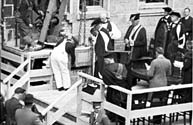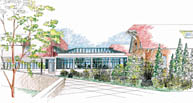Newsbites
Historic Occasion

McGill Archives
On October 6, 1933, the cornerstone of the Montreal Neurological Institute was laid at an impressive ceremony presided over by McGill's Principal, World War I general Sir Arthur Currie. Dr. Wilder Penfield, a highly respected young brain surgeon attracted to McGill five years earlier, had been the driving force behind the planning of the Institute.
Penfield recognized that neurologists, neurosurgeons and scientists would work most effectively by combining their activities under one roof. He applied to and eventually was awarded $1.2 million by the Rockefeller Foundation of New York City toward the cost of building the MNI. Currie had used his influence to help secure the Rockefeller grant and raised money from the Quebec and Montreal governments, as well as private citizens, to complete the funding.
Neurosurgeon Dr. William Feindel, a former head of the MNI, helped plan this year's 70th anniversary. He takes up the story. "At an early stage of the project, the estimated cost of the building threatened to exceed the budget by 10%. Currie called Penfield down to his office and declared, 'We must cut the coat to fit the cloth.' Currie had plans on the table to remove the two top floors, intended for laboratories and animal quarters. This omission would have wiped out the research potential of the Institute. Penfield was appalled. 'You will have to go ahead with this project without meÖno one will want this coat as you have cut it!'"
Tense discussions followed, but Penfield finally persuaded Principal Currie that the Institute would pay for itself once it opened, and construction went forward. There were more controversies along the way and some budget-trimming deletions (one unfinished lab space was used as a squash court for ten years), but Currie remained a champion of the project throughout.
At the cornerstone ceremony, Currie declared that the MNI "will provide facilities which will enhance the usefulness and reputation of our hospitals in the medical schools not only of this city but of all Canada."
Just over three weeks later, Currie collapsed into a coma following a stroke and was cared for by, among others, Wilder Penfield. He contracted pneumonia and died at the end of November. The MNI opened the following year and ever since has borne out the prescience of the two great men who built it.
Centennial Project

Courtesy Werleman Guy McMahon Architectes
There's new construction happening all over McGill and Macdonald Campus is no exception. As part of Mac's 100th anniversary celebrations in 2006, there are plans to enlarge and refurbish its library facilities. Housed since 1976 in the converted Barton Horticultural Barn, the present library falls short of current student and faculty needs. Fundraising has begun for the new, spacious structure which will link the Barton and Macdonald-Stewart Buildings. By doing so, the new library will become the heart of the campus community, as it was almost a century ago.
It will include such modern-day essentials as 24-hour computer access, an electronic classroom for group library instruction, and quiet study zones where students can work alone or in groups. Library use by the 1,300 students and 90 faculty members on the West Island campus translates into 90,000 individual visits each year. Growth in technology and the importance of maintaining an edge in the ever more competitive academic world, as well as expanding student enrolment, make the need for an updated facility even more urgent.
The new building is already being anticipated with great enthusiasm by students and staff alike. Kelly Faubert, a student in Natural Resource Sciences, sums up the feeling: "Having a sunny, airy place to sit and work together would be great! It's exactly what we need. This is an environmental faculty, and we need an 'environmental' place to meet that is accessible from all the buildings."


